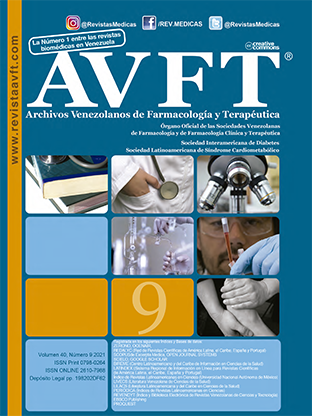Level of radicular stress in upper premolars and pressure exerted in adjacent tissues: a 3D mechanical model
Keywords:
radicular stress, posts, splint effect, 3D simulation.Abstract
Objective: To compare the level of radicular stress and pressure exerted on adjacent tissues in 1.4 upper premolars with effect and without effect, vertical and axial compression splint in prefabricated posts, fiberglass and titanium vs cast noble metal (Au) and nickel chromium (NiCr) cast metal studs, cemented with self-adhesive self-conditioning resinous cement using the finite element technique. Materials and Methods: An experimental and comparative study was carried out with 8 simulated 3D models of 1.4 upper premolars. The FEMAP 11.1.2 software was used to model the mechanical design in 3D. Results: The radicular stress level is higher in the prefabricated cast Au and NiCr posts both at 360 and 180º compared to the fiberglass and titanium ones, the most representative average being in the NiCr at 360º with 104.23 Mpa and the lowest in Titanium 180º with 83.79 Mpa. The pressure exerted on adjacent tissues, in the premolars, has a higher level in prefabricated posts based on fiberglass and titanium at 180º compared to those made of noble metal and nickel-chromium, the most representative being that of smooth fiberglass at 180º with 1.43 and the lowest is the 360º NiCr with 1.30. Conclusion: The radicular stress level is higher in pre-cast Au and NiCr posts both at 360 and 180º compared to fiberglass and titanium posts, and the level of pressure exerted on adjacent tissues in the premolars has a higher level in prefabricated fiberglass and titanium bolts, both at 180º, compared to Au and NiCr.
Downloads
References
Ree M, Schwartz RS. The endo-restorative interface: current concepts. Dent Clin North Am. 2010;54(2):345-74.
Gbadebo O, Ajayi D, Oyekunle O, Shaba P. Randomized clinical study comparing metallic and glass fiber post in restoration of endodontically treated teeth. Indian J Dent Res. 2014; 25(1): 58-63.
Abo O, Atta O, El-Mowafy O. Fracture resistance of anterior teeth restored with a novel nonmetallic post. J Can Dent Assoc. 2008; 74(5): 441-441.
American Association of Endodontics. Evidence-based review of clinical studies on restorative dentistry. J Endod. 2009; 35(8): 1111-1115.
Ozkurt Z, Işeri U, Kazazoğlu E. Zirconia ceramic post systems: a literature review and a case report. Dent Mater J. 2010; 29(3): 233-245.
Chen YW, Stanley K, Att W. Artificial intelligence in dentistry: current applications and future perspectives. Quintessence Int. 2020;51(3):248-257.
Alauddin MS, Baharuddin AS, Mohd Ghazali MI. The Modern and Digital Transformation of Oral Health Care: A Mini Review. Healthcare (Basel). 2021;9(2):118.
Spagnuolo G, Sorrentino R. The Role of Digital Devices in Dentistry: Clinical Trends and Scientific Evidences. J Clin Med. 2020; 9(6): 1692.
Tucker S, et al. Comparison of actual surgical outcomes and 3-dimensional surgical simulations. J Oral Maxillofac Surg. 2010;68(10):2412-21.
Pegoretti A, Fambri J, Zappini G, Bianchetti M. Finite element analysis of a glass fibre reinforced composite endodontic post. Biomaterials. 2002;23(13): 2667-2682.
Gholami F, Kohani P, Aalaei S. Effect of Nickel-Chromium and Non-Precious Gold Color Alloy Cast Posts on Fracture Resistance of Endodontically Treated Teeth. Iranian Endodontic Journal. 2017;12(3): 303-306.
Gómez A, Chica E, Latorre F. Análisis de la distribución de esfuerzos en diferentes elementos de retención intrarradicular prefabricados. Revista Facultad de Odontología Universidad de Antioquia. 2008; 20(1): 31-42.
Durmuş G, Oyar P. Effects of post core materials on stress distribution in the restoration of mandibular second premolars: a finite element analysis. J Prosthet Dent. 2014; 112(3): 547-554.
Nokar S, Bahrami M, Mostafavi A. Comparative Evaluation of the Effect of Different Post and Core Materials on Stress Distribution in Radicular Dentin by Three-Dimensional Finite Element Analysis. J Dent (Tehran). 2018; 15(2): 69-78.
Downloads
Published
How to Cite
Issue
Section
License
Copyright (c) 2023 AVFT – Archivos Venezolanos de Farmacología y Terapéutica

This work is licensed under a Creative Commons Attribution-NonCommercial-NoDerivatives 4.0 International License.




